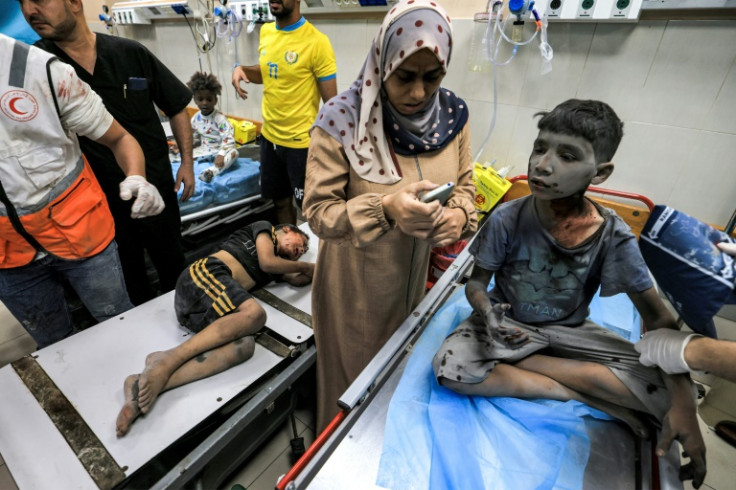Israel-Hamas War Caused Around 14% Jump in Acute Malnutrition in Gaza Children: WHO Report
Gaza children and pregnant and breastfeeding women are surviving on less than two meals a day of the lowest nutritional value because of the Israel-Hamas war, resulting in acute malnutrition.

The deteriorating Gaza crisis is taking a heavy toll on Palestinian children as acute malnutrition is increasing in the population, says a new report by the World Health Organisation (WHO).
According to a detailed analysis done by the Global Nutrition Cluster of WHO, malnutrition in Gaza children has seen a steep rise since the Israel-Hamas war started. Not just children, but pregnant and breastfeeding women are also suffering from malnutrition because of the humanitarian crisis.
This comes at a time when UNICEF has reported that over 17000 Gaza children have lost parents in the Israel-Hamas conflict.
The report found that one in six Gaza children below the age of two are suffering from acute malnutrition, especially in Northern Gaza.
In its 20th week, Israel's war on Hamas food and water scarcity along the Gaza Strip, causing the outbreak of diseases and affecting the health of women and children as they suffer from low immunity and acute malnutrition, said the WHO report titled 'Nutrition Vulnerability and Situation Analysis - Gaza'.
The northern part of Gaza which has been cut off from receiving any humanitarian aid by the Israeli Defence Forces (IDF) is the worst hit as 15.6 per cent of children below the age of two are found to be malnourished. Nearly three per cent of them are suffering from severe wasting, a life-threatening form of malnutrition. This percentage of Gaza children needs urgent treatment to prevent death or medical complications.
Before the October 7 Hamas attack on Israel and the subsequent war, only 0.8 per cent of children below the age of five had acute malnutrition and severe wasting was rare. From that to 15.6 per cent in January 2024 shows how rapidly health conditions have declined in Gaza.
This is the sharpest fall in nutritional status in any population in three months in the world. It's an unprecedented situation globally, said WHO.
The report further revealed that 95 per cent of pregnant and breastfeeding women in Gaza are going through severe food poverty while 90 per cent of Gaza children below two years of age are in severe poverty. These people had less than two meals the day before the survey and their food is of the lowest nutritional value.
WHO has made it clear that the situation in Gaza could be worse than reported as the study was done in January and since then Israel has attacked the last unoccupied town in Southern Gaza, Rafah.
While humanitarian aid has been reaching Rafah earlier the situation might be affected now. The WHO report found five per cent of children below the age of two in Rafah are suffering from acute malnutrition. This vindicates the call to protect Rafah from military operations by various human rights agencies.
The disparity in malnutrition in Southern and Northern Gaza has pointed out the necessity of more humanitarian aid in Gaza as they can help prevent the worst outcomes.
UNICEF Deputy Executive Director for Humanitarian Action and Supply Operations, Ted Chaiban said: "The Gaza Strip is poised to witness an explosion in preventable child deaths which would compound the already unbearable level of child deaths in Gaza."
"We've been warning for weeks that the Gaza Strip is on the brink of a nutrition crisis. If the conflict doesn't end now, children's nutrition will continue to plummet, leading to preventable deaths or health issues which will affect the children of Gaza for the rest of their lives and have potential intergenerational consequences," Chaiban added.
Malnourished Gaza children getting more prone to infectious diseases
Around 64 percent of Palestinian households are surviving on one meal a day while 95 percent are limiting meals or portioning sizes. Adults in more than 95 per cent of households in Gaza are eating less to feed their children.
Calling this acute malnutrition in Gaza "dangerous and preventable", the Assistant Executive Director for World Food Programme (WFP) Operations, Valerie Guarnieri said: "Children and women, in particular, need continuous access to healthy foods, clean water and health and nutrition services. For that to happen, we need decisive improvements on security and humanitarian access, and additional entry points for aid to enter Gaza."
At present Gaza households are living on less than one litre of safe water per person per day which is one-third of the three litres needed in an emergency. The overall humanitarian standard for water is 15 litres per person per day for drinking, washing and cooking.
This hunger and thirst has resulted in weakness in Palestinians living along the Gaza Strip with most of them falling sick. The WHO report found 90 per cent of children below the age of five have one or more infectious diseases. Around 70 percent of the Gaza children had diarrhoea in the past two weeks of the survey which is 23 fold increase from the 2022 figures.
The Executive Director of the WHO Health Emergencies Programme, Dr Mike Ryan called "hunger and disease a deadly combination".
"Hungry, weakened and deeply traumatised children are more likely to get sick, and children who are sick, especially with diarrhoea, cannot absorb nutrients well. It's dangerous and tragic, and happening before our eyes," Dr Ryan added.
© Copyright IBTimes 2025. All rights reserved.






















